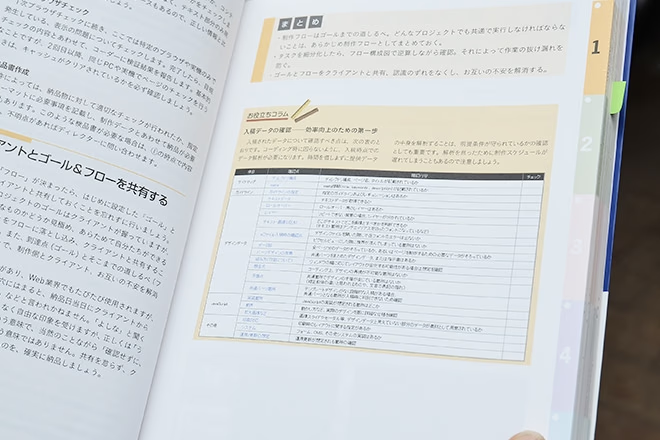コーディングファクトリー部(以下CF)の和田です。
突然ですが、みなさんは昨年発売された『フロントエンド専門制作会社が教える 速く正確なWeb制作のための実践的メソッド』(Amazon)をご存知ですか?コーダーやフロントエンドエンジニア、ディレクターなど、Web制作に携わるさまざまな方に向けて、CFメンバーが制作現場の実践的なメソッドをまとめた本です。
発売時、私は別の部署に所属していたので、本の制作には関わっておらず、いち読者としてひととおり読んでいました。今年からCFに異動したこともあり、実際にCFがどんな仕事をしているのかを感じるなかで、CFのナレッジがたくさん詰まったこの本を、改めてじっくりと読み直してみることにしました。
そもそも、これってどんな本?
この本は、いわゆる一般の技術書とはひと味違って、実際の現場ですぐに取り入れられる「実践的メソッド」が全5章にわたって散りばめられています。
目次はこんな感じです。
Chapter1:制作フローと環境の構築
Chapter2:コーディングガイドラインの策定
Chapter3:速く正確で安全なコーディングメソッド
Chapter4:ディレクションとチェックの勘どころ
Chapter5:質と効率を高めるWeb制作の仕事術
まず興味を持ったのは「第4章」
さて、どこから読むか。まず私は、「Chapter4:ディレクションとチェックの勘どころ」から読み始めました。導入ページに書かれていた内容をざっくり説明すると…
Web制作をする上で大切なこと、それはページを制作するための技術力はもちろんですが、それと同じくらい 大事なことは、実はディレクションであること。
制作進行には、段取りやリスクに対する配慮が欠かせません。段取りよく制作を進めるための進行管理や、そのために必要なコミュニケーションをとること。
これらを実現するための具体的な Tips が本章では紹介されています。
また、とっても惹かれた一文がありました。
これらのポイントをきちんと押さえて実践することができれば、スマートで効率のよいプロジェクト進行が体感できるでしょう。また、よりコーディングに集中することができるようになります。
「よりコーディングに集中することができるようになります。」
コーディングに集中したい!
それは私が最近常々思っていることでした。
私はコーディングもしますが、クライアントとのやりとりであるディレクションも行います。ディレクションはクライアントとのやりとりであったり、一緒に案件を進めるパートナーさんの進捗確認や連絡であったり多岐に渡りますが、ディレクションの業務というのは、工数の見積もりが難しいと常々感じていました。
ディレクターは、人と人との間に立って、作業を進めやすいように物事を伝える、それも迅速に的確に伝えることが仕事です。そのため、自分が担当するコーディング作業などは後回しになってしまい、気づけば夜になって、何も手をつけられていなかったということも度々ありました。ディレクション業務をやりつつ、コーディングもスムーズに進めたい!そんな思いで読み始めた第4章で特に印象に残ったことは、「必ずやらなければならないこと/やらなくてもいいこと」の部分です。

「やる、やらない」その切り分けが大事
プロジェクトが始まったら、まず、何から手をつけたらいいのか。
やるべきことができていなかったり、やらなくてもいいことに時間を割いてしまうことがないように、常に効率とクオリティのアップを意識することを本書は促しています。
例えば以下ような「必ずやる」こと、「やらなくていい」ことがあります。
納品日にどのようなデータが何時までに必要なのかという確認は「必ずやる」
まずは納品に関する確認、これは重要です。納品方法や、納品時間、納品後の修正・変更対応をいつやるかなどはあらかじめクライアントと認識合わせをしておくと、納品日の納品対応で慌ててミスをしてしまったり、納品完了の終わりが見えない不安が続くことが減らせるので、大変重要だと思います。
これについては、私も納品日にクライアントとのやりとりで経験したことがあります。納品後の急な変更対応などが発生したときに、どこまで対応をするのか、どこまで対応すれば終了なのか、その返事をクライアントに確認しておかないと、いつまでも対応が終わらず想定以上の時間が必要になり、他に進めているプロジェクトに影響を与えてしまいます。
これらの対策方法は、私がクライアントとのやりとりに迷っていたとき、真っ先に部長の児嶋から教えてもらったことでした。本書の中にはそれらの現場の生きたノウハウが紹介されています。
自分で決められないことにあれこれ悩まない「やらなくていい」
自分自身が実際に作業したことがないことの工数出しは、実際にやってみるか、やったことのある人の話を聞きくのがよいと、本書には書かれています。
自分がいくら考えてみてもわからないことや、調べてみても解決できなさそうなことは、早めに周りの人に相談する必要があります。私自身も、制作を進める上で、初めてやることや、やり方がわからないことは、以前対応した経験がある制作者に聞いて、やり方を教わることが多いです。
周りのメンバーもそれぞれの業務を抱えており、忙しそうなので、なかなか自分のわからないことを質問するタイミングが難しいと思うこともありますが、そこは、聞かないと進められないので、勇気を出して聞くことが必要です。
その際に、私がいつも気をつけていることは、ただわからないと言うのではなく、相手が質問に答えやすいような聞き方をすることです。例えば、「◯◯のこの部分がわからないので、調べてみたらこういう結果が出たのですが、この進め方でいいでしょうか?」というようなやり方や、2案提案して、「1案2案のどちらが今回の場合適切でしょうか?」などといったように1か2を選択してもらったりします。
この質問の仕方は、第4章の「スマートなコミュニケーションで快速ディレクション」の「返答がしやすい質問のポイント」にもわかりやすく書かれてありました。社内のやりとりだけでなく、クライアント含め、人に何かを聞く・確認するときに有効なやり方だということを再認識しました。
このように、なかなか本には書かれていない現場のノウハウが詰まった第4章。実は執筆の中心となった松原も「特に読んでください!」と力説していた章でした。(詳しくはこちら)やはり現場のニーズにマッチしています!
この他にも、役立つ内容が盛りだくさん
もちろん、第4章以外にも役立つ内容がたくさん書かれています。

特に私が気に入ったのは、各章の間にでてくる「お役立ちコラム」です。名前の通り現場ですぐに役に立つ内容が書かれています。最初のコラムでは、「入稿データの確認ーー効率向上のための第一歩」として、入稿されたデータで確認するポイントがチェックリストとしてまとめられてあります。プロジェクトを進めていくと、クライアントに確認しなければ進められないことがいくつか出てきます。これを最初に潰しておくかおかないかでは、後からの作業に大きく響きます。
他にも「押さえておきたいコーディングの基本」についての記述はもちろん、ページの表示崩れの際の「なんで崩れるのかわからない……」に対する早い解決のしかたなども載っており、ここを読めば、実際に制作現場で起こりがちなトラブルにも迅速に対応できます。
また、本書の最後には「メンタルコントロール・メンタルケア」についても書かれています。この部分は一番驚いた部分ですが、Web 制作の現場に関わらず、どのような仕事をする上でも必要なことです。仕事をする上での心を持ち方、モチベーションの高い仕事の仕方について書かれてあります。
今回改めて CF が作った本を読んでみて、技術だけじゃなくプロジェクトの進め方に役立つ本であり、現場のノウハウが詰め込まれた現場ですぐに使える本だと強く感じました。
コーダーだけじゃなく、ディレクターの方もぜひ!

株式会社モノサス/コーディングファクトリー(著)
『フロントエンド専門制作会社が教える 速く正確なWeb制作のための実践的メソッド』 (マイナビ出版)

